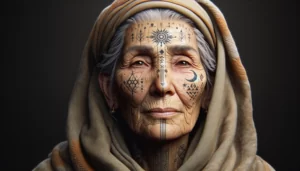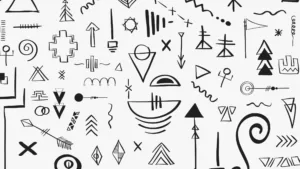Amazigh tattoo face art is a captivating form of indigenous art that embodies the rich cultural heritage and tribal identity of the Amazigh people. Originating from North Africa, the Amazigh culture is known for its vibrant music, symbols, and art. The presence of Amazigh motifs and symbols can be found in various forms of craft, including tattoos, pottery, jewelry, and carpets, showcasing the importance of these symbols in representing Amazigh cultural identity and the deeper meanings they hold.
Key Takeaways:
- Amazigh tattoo face art is a form of indigenous art that reflects the cultural heritage of the Amazigh people.
- The Amazigh culture is known for its vibrant music, symbols, and art forms.
- Amazigh symbols can be found in various forms of craft, including tattoos, pottery, jewelry, and carpets.
- These symbols hold deep cultural meanings and represent Amazigh cultural identity.
- Amazigh tattoo face art is an important aspect of preserving and celebrating Amazigh heritage.
The Historical Significance of Amazigh Tattoo Face Art
Amazigh tattoo face art holds a deep historical significance in the cultural heritage of the Amazigh people. These intricate tattoos, adorned on the faces of individuals, carry ancient roots that date back to pre-Islamic times. The tradition of Amazigh tattoos has been passed down through generations, serving as a powerful symbol of identity, protection, and spirituality.
The Ancient Roots of Amazigh Tattoos
The practice of Amazigh tattooing can be traced back to the indigenous tribes inhabiting North Africa for centuries. The Amazigh people, also known as the Berbers, have long used tattoos as a means of self-expression and cultural representation. These ancient roots signify the deep connection between the Amazigh people and their ancestral heritage.
Protective and Spiritual Meanings Behind the Tattoos
Amazigh facial tattoos carry symbolic meanings that are both protective and spiritual in nature. These intricate designs are believed to ward off evil spirits and provide spiritual and emotional protection to the wearer. Each unique pattern and motif holds a specific significance, reflecting the personal beliefs and experiences of the individual.
Tattoos as a Rite of Passage in Amazigh Culture
Within Amazigh culture, tattoos are not just a form of artistic expression, but also an important rite of passage. They symbolize significant milestones and transitions in life, marking moments of growth, maturity, and personal transformation. Through the act of tattooing, individuals are initiated into the community and embrace their cultural identity with pride.
The Rich Symbology of Amazigh Tattoos

Amazigh tattoos are more than just decorative body art; they are infused with deep cultural meaning and symbolism. The intricate geometric designs, such as triangles, lines, diamonds, and dots, hold significant importance within Amazigh tattoo art. These symbols are representative of the spirituality, fertility, and protection that are central to Amazigh culture.
The geometric designs used in Amazigh tattoos are not merely aesthetic; they serve as powerful visual representations of cultural values and beliefs. The use of triangles, for example, symbolizes strength and stability, while lines represent balance and harmony. Diamonds embody protection and ward off negative energy, while dots convey a sense of connection and continuity.
Amazigh tattoos are deeply embedded in the cultural fabric of the Amazigh people, and they hold immense cultural importance. These tattoos serve as expressions of identity, heritage, and a connection to the ancestral roots of the Amazigh community. They are a way for individuals to proudly showcase their Amazigh heritage and spirituality, while also honoring their ancestors and passing down cultural traditions to future generations.
Amazigh tattoos are not just a form of body art; they are a visual language that communicates the rich history, cultural heritage, and spiritual beliefs of the Amazigh people. The symbology and geometric designs used in these tattoos encapsulate the essence of Amazigh culture and provide a window into the spiritual and cultural world of the Amazigh community.
Amazigh Tattoo Face: A Dying Art Form
In recent years, the ancient art of Amazigh tattoo face has been facing the threat of extinction. This dying art form, deeply rooted in Amazigh culture and identity, is slowly fading away due to the impact of religion and modernization, as well as generational shifts in perceptions. However, despite the challenges, there are ongoing preservation efforts to revive and safeguard this indigenous body art tradition.
The Impact of Religion and Modernization
The decline of Amazigh tattoo face can be attributed to the influence of religion and the pressures of modernization. As the Amazigh people have come into contact with other cultures and ideologies, the traditional practice of tattooing has been discouraged or even forbidden for religious reasons. The rise of conservative beliefs and the influence of Islam have led to a decline in the acceptance and practice of Amazigh tattoo face art.
Furthermore, the increasing modernization of Amazigh communities has also played a role in the fading popularity of tattooing. As societies become more interconnected and influenced by global trends, traditional practices, and cultural expressions tend to diminish in importance. The younger generations, in particular, are often more drawn to contemporary forms of self-expression and may view the Amazigh tattoo face as outdated or irrelevant in today’s world.
Generational Shifts in Amazigh Tattoo Perceptions
With each passing generation, there has been a noticeable shift in the way Amazigh tattoos are perceived. While the older generation still values and embraces this ancient form of body art, younger individuals are often more hesitant to engage with it. This generational divide can be attributed to a variety of factors, including changing societal norms, shifting cultural values, and external influences.
As conservative attitudes become more prevalent, the younger generation may perceive Amazigh tattoos as a deviation from mainstream ideals or an act of rebellion. The pressure to conform to societal expectations and the fear of being stigmatized can discourage young people from participating in the practice of Amazigh tattooing, leading to its decline.
Preservation Efforts of Indigenous Body Art
Despite the challenges faced by the Amazigh tattoo face art form, there are ongoing efforts to preserve and revitalize this unique cultural tradition. Organizations, artists, and community members are working tirelessly to document and promote the art of Amazigh tattoos, ensuring that it is not forgotten.
These preservation efforts involve initiatives such as cultural festivals, exhibitions, and educational programs that seek to raise awareness about Amazigh tattoo face and its cultural significance. By celebrating and showcasing the beauty and symbolism of this ancient art form, these efforts aim to inspire a renewed appreciation for Amazigh tattoo face and encourage its continued practice.
The image above illustrates the intricate and meaningful designs that characterize Amazigh tattoo face. It serves as a visual reminder of the beauty and complexity of this dying art form.
Decoding the Meanings: A Guide to Amazigh Symbols
Amazigh symbols used in tattoos hold deep cultural significance and represent various aspects of Amazigh life and beliefs. To understand the meanings behind these symbols, it is important to delve into the rich cultural heritage of the Amazigh people. From spirituality to protection, each symbol carries its own unique significance.
(Include a relevant quote or statement about the importance of understanding the meanings of Amazigh symbols.)
To help in decoding these symbols, here is a comprehensive guide:
- Geometric Designs: Amazigh tattoos often feature geometric shapes such as triangles, lines, diamonds, and dots. These shapes represent balance, harmony, and symmetry, reflecting the interconnectedness of nature and the universe.
- Spiritual Symbols: Amazigh symbols also carry spiritual meanings. For example, the Tashelhit symbol, known as the “hand of Fatima” or “Khmissa,” represents protection against the evil eye and negative energies.
- Nature Imagery: Amazigh symbols frequently incorporate elements from nature, such as animals, plants, and natural phenomena. Each element carries its own symbolism, representing qualities like strength, fertility, or the cycle of life.
- Mystical Icons: Some symbols found in Amazigh tattoos have connections to ancient mystical beliefs and practices. These symbols may represent cosmic forces, rituals, or the relationship between humans and the spiritual realm.
- Traditional Tattoo Methods: The creation of Amazigh tattoos involves traditional methods passed down through generations. Skilled artisans use tools like a hand-held needle called a “misrak” or a traditional tattoo hammer called a “talakht” to create intricate designs on the skin.
(Include a relevant quote or statement about the craftsmanship and skills involved in traditional Amazigh tattoo methods.)
Decoding the meanings behind Amazigh symbols adds depth and understanding to the art of Amazigh tattoos. By exploring the cultural significance and traditional tattoo methods, we can appreciate the richness and complexity of this ancient craft.
| Symbol | Meaning |
|---|---|
| Tashelhit Symbol | Protection against the evil eye and negative energies |
| Triangle | Represents balance, harmony, and interconnectedness |
| Hand of Fatima | Symbolizes protection and good fortune |
| Snake | Represents transformation and rebirth |
| Tree of Life | Symbolizes the cycle of life and connection to nature |
Feminine Empowerment Through Amazigh Tattoos
Amazigh tattoos hold a deep cultural significance and play a major role in feminine empowerment within Amazigh communities. Women have long been integral to the tattooing traditions of the Amazigh people, both as the creators of these artistic symbols and as the wearers of these tattoos themselves.
The role of women in Amazigh tattooing traditions goes beyond mere decoration. It is a way for women to reclaim their identity, express their cultural heritage, and assert their autonomy. Through the art of tattooing, Amazigh women find a powerful form of self-expression and a means of celebrating their unique cultural identity.
A prominent aspect of Amazigh tattooing is the tradition of facial tattoos. These facial tattoos are not only symbols of beauty, but they also serve as a powerful marker of identity. It is a way for Amazigh women to proudly display their cultural heritage and assert their place within their community.
The facial tattoos often consist of intricate geometric designs, reflecting the rich artistic tradition of the Amazigh people. These tattoos are a testament to the skill and craftsmanship of the tattoo artists, as well as the bravery and resilience of the women who choose to wear them.
Facial tattoos are seen as a marker of beauty, strength, and resilience, rejecting the societal norms that dictate beauty standards. Amazigh women defy these conventional standards and embrace their own definition of beauty, rooted in their cultural heritage and traditions.
Furthermore, facial tattoos also serve as a form of protection. In Amazigh culture, it is believed that facial tattoos act as a shield against evil spirits, protecting the wearer from harm. They are seen as a source of spiritual and emotional protection, empowering Amazigh women to navigate the challenges they may face in their lives.
Through Amazigh tattoos, women find empowerment, pride, and a deep connection to their cultural roots. It is a form of self-expression that embodies the resilience, strength, and identity of Amazigh women. The art of Amazigh tattooing is not just a visual representation, but a living testament to the enduring spirit of feminine empowerment within Amazigh communities.
Contemporary Interpretations of Traditional Amazigh Tattoos
In the world of tattoo artistry, traditional Amazigh tattoos are experiencing a contemporary revival. Modern tattoo artists are embracing the intricacies and cultural significance of Amazigh symbols and designs, blending them seamlessly with the techniques and styles of modern tattooing. By incorporating traditional Amazigh motifs into their work, these artists are paying homage to the rich heritage of the Amazigh people while creating captivating and meaningful tattoos for a modern audience.
Contemporary interpretations of traditional Amazigh tattoos showcase the creativity and innovation within the tattooing community. Artists are taking inspiration from historical Amazigh designs, adapting them to suit the preferences and aesthetics of their clients. While staying true to the essence of Amazigh symbolism, they incorporate new elements and techniques, resulting in unique and personalized tattoo art.
“The beauty of traditional Amazigh tattoos lies in their timeless appeal. By integrating them into my modern designs, I can bring a piece of history and cultural heritage to life on the skin of my clients.” – Lisa Rodriguez, Tattoo Artist
With the advancements in modern tattooing equipment and techniques, artists can expertly translate the intricate and detailed designs of traditional Amazigh tattoos onto the skin. The use of vibrant colors, shading techniques, and three-dimensional effects allows for a contemporary twist on traditional Amazigh motifs, adding depth and dimension to the artwork.
By embracing contemporary interpretations of traditional Amazigh tattoos, tattoo enthusiasts have the opportunity to not only adorn their bodies with stunning visuals but also connect with the rich cultural heritage of the Amazigh people. These tattoos act as a form of self-expression, allowing individuals to showcase their appreciation for indigenous art and culture.
| Traditional Amazigh Tattoos | Contemporary Interpretations |
|---|---|
| Black ink | Colorful and vibrant designs |
| Simple geometric shapes | Complex and intricate designs |
| Symbolic meanings | Personalized and meaningful tattoos |
| Hand-poked technique | Modern tattoo machine technique |
The table above highlights the key differences between traditional Amazigh tattoos and their contemporary interpretations. While traditional tattoos feature black ink and simple geometric shapes with symbolic meanings, contemporary interpretations embrace vibrant colors, complex designs, and personalized tattoos created with modern tattoo machines.
Contemporary interpretations of traditional Amazigh tattoos not only keep the ancient symbolism alive but also provide a bridge between the past and the present, honoring the heritage of the Amazigh people while embracing the evolution of tattoo artistry.
Geometric Mastery in Amazigh Tattoo Designs

Amazigh tattoo designs are renowned for their geometric mastery, showcasing the skill and precision of Amazigh artisans. These intricate designs incorporate a wide range of shapes that hold deep cultural significance, reflecting the rich heritage of the Amazigh people.
The Significance of Shapes: Triangles, Diamonds, and Lines
Shapes play a crucial role in Amazigh tattoo designs, each holding its own symbolism and meaning. Triangles, for example, are often used to represent the three main elements of life: earth, water, and air. They are seen as a symbol of strength, stability, and balance.
Diamonds are another common shape found in Amazigh tattoos. They are associated with femininity, fertility, and protection. The diamond shape is believed to bring good luck and ward off evil spirits, making it a popular choice for Amazigh women.
Lines are a fundamental element of Amazigh tattoo designs, representing connectivity and flow. They can symbolize the interconnectedness of different aspects of life or the passage of time. Lines are often used to create intricate patterns and add depth to the overall design.
Understanding the Complex Geometry in Amazigh Art
Amazigh art is characterized by its complex geometry, with every line and shape carefully planned and executed. The artisans behind these designs possess a deep understanding of the mathematical principles that underlie Amazigh art.
The complex geometry in Amazigh art is not merely decorative but holds deeper spiritual and cultural significance. It reflects the belief in the interconnectedness of the universe and the harmony between the physical and spiritual realms. The intricate patterns and symmetrical arrangements are a testament to the mastery of Amazigh artisans.
To truly appreciate the complexity and beauty of Amazigh tattoo designs, one must understand the cultural context and significance of the shapes and patterns used. The geometric mastery displayed in these tattoos is a testament to the skill and creativity of Amazigh artists, preserving a centuries-old tradition in a contemporary form.
The Artistic Expression in Amazigh Tattoos and Beyond
Amazigh tattoos are not only a form of personal adornment but also a powerful artistic expression that reflects the rich cultural heritage of the Amazigh people. The craftsmanship involved in creating these tattoos is a testament to the skilled artisans who meticulously ink each design. However, the artistic expression of the Amazigh people extends well beyond tattoos, encompassing other forms of craftsmanship such as pottery, jewelry, and weaving patterns.
Craftsmanship in Amazigh Pottery and Jewelry
Amazigh pottery and jewelry are renowned for their exquisite craftsmanship and attention to detail. Each piece is meticulously handcrafted, showcasing intricate designs and motifs that are deeply rooted in Amazigh culture. The pottery often features geometric patterns, bold colors, and decorative elements that reflect the rich artistic traditions of the Amazigh people. Similarly, Amazigh jewelry is characterized by its unique style, incorporating intricate engravings, vibrant gemstones, and symbolic motifs that convey a sense of cultural pride and identity.
Parallels Between Tattoo Art and Weaving Patterns
An interesting parallel can be drawn between Amazigh tattoo art and traditional weaving patterns. Both forms of artistic expression utilize geometric designs and symbols to convey deeper meanings and cultural significance. Amazigh weaving patterns, often found in carpets and textiles, reflect the same attention to detail and precision seen in tattoo art. These weaving patterns not only serve as decorative elements but also tell stories and convey important cultural messages. The intricate geometric motifs found in both tattoos and weaving patterns showcase the interconnectedness of various artistic expressions within Amazigh culture.
By exploring the artistic expression in Amazigh tattoos and its connections to other forms of Amazigh craftsmanship, we gain a deeper appreciation for the richness and diversity of Amazigh culture. Whether through tattoos, pottery, jewelry, or weaving patterns, the artistic expression of the Amazigh people continues to thrive, preserving their cultural heritage and captivating the world with their craftsmanship.
Challenges and Controversies Surrounding Amazigh Tattoos Today
The practice of Amazigh tattoos faces several challenges and controversies in contemporary times. Social and cultural obstacles hinder the widespread acceptance and practice of this ancient art form. One of the significant challenges comes in the form of religious restrictions, with some interpretations of Islam discouraging or forbidding tattoos. These restrictions create barriers for those who wish to express their Amazigh cultural identity through tattooing.
Additionally, societal stigmas and misconceptions surrounding Amazigh tattoos contribute to the controversy. Some individuals, influenced by misinformation or biased perspectives, view these tattoos as archaic or associated with criminal behavior. Such negative perceptions impact the broader acceptance of Amazigh tattoos and can discourage individuals from proudly displaying their cultural heritage.
Despite these challenges, Amazigh communities are fighting for cultural recognition and autonomy. They are actively advocating for the preservation and celebration of their rich cultural heritage through the practice of tattooing. By educating others about the symbolism and significance of Amazigh tattoos, they aim to challenge the stereotypes and misconceptions that surround this ancient art form. Through these efforts, they seek to ensure the continued practice and appreciation of Amazigh tattooing.
FAQ
What is the cultural significance of Amazigh tattoo face art?
Amazigh tattoo face art holds deep cultural symbols that represent the rich heritage of the Amazigh people, their identity, spirituality, and protection.
What is the historical significance of Amazigh tattoo face art?
Amazigh tattoo face art has ancient roots, dating back to pre-Islamic times. These tattoos were believed to offer protection against evil spirits and were utilized as a rite of passage in Amazigh culture.
What are the symbols commonly used in Amazigh tattoos and what do they represent?
Amazigh tattoos feature geometric designs such as triangles, lines, diamonds, and dots. These symbols hold cultural importance, representing spirituality, fertility, and protection.
Is Amazigh tattoo face art a dying art form?
Yes, the practice of Amazigh tattoo face art is declining due to the influence of religion and modernization. However, efforts are underway to preserve and revitalize this traditional practice.
How can one decode the meanings of Amazigh symbols used in tattoos?
Decoding the meanings of Amazigh symbols requires an understanding of their cultural significance and traditional tattoo methods used by Amazigh artisans, showcasing the craft and skills involved.
What is the role of women in Amazigh tattooing traditions?
Women play a significant role in Amazigh tattooing traditions, both as creators of symbols and as wearers of tattoos. Facial tattoos, in particular, hold cultural importance as markers of beauty and identity for Amazigh women.
How do contemporary tattoo artists incorporate Amazigh symbols into their work?
Contemporary tattoo artists adapt traditional Amazigh motifs and designs, infusing them into modern tattoo artistry while preserving the cultural heritage and symbolism associated with Amazigh tattoos.
What is the significance of geometric designs in Amazigh tattoo art?
Geometric mastery is showcased in Amazigh tattoo designs through specific shapes like triangles, diamonds, and lines. These shapes hold deeper meanings and contribute to the complex geometry found in Amazigh art.
How is Amazigh tattoo art connected to other forms of Amazigh craftsmanship?
Amazigh tattoo art shares connections with other forms of Amazigh craftsmanship such as pottery, jewelry, and weaving patterns. These artistic expressions highlight the skilled craftsmanship and interconnectedness within Amazigh culture.
What are the challenges and controversies surrounding Amazigh tattoos in contemporary times?
Challenges include social and cultural obstacles like religious restrictions and societal stigmas. However, there is an ongoing fight for cultural recognition and autonomy as Amazigh communities strive to preserve and celebrate their heritage through tattoo practices.




